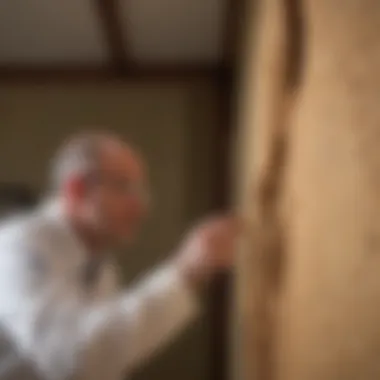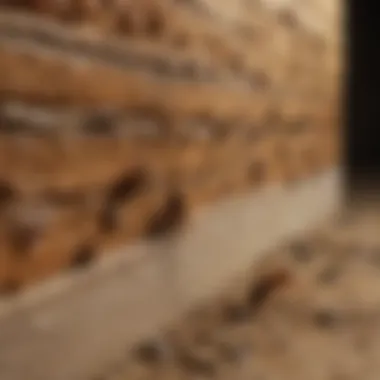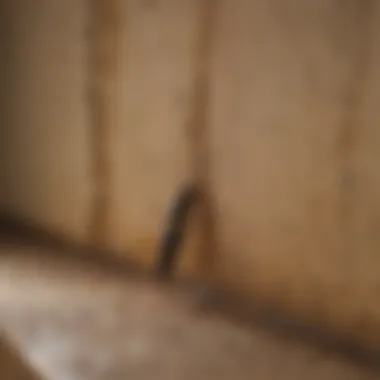Understanding the Cost of Termite Damage Repair


Intro
Termite damage can result in extensive financial burdens for homeowners. Understanding the cost to fix this type of damage is essential for effective property management. With numerous factors influencing repair expenses, it becomes vital to comprehend the underlying elements of termite control, treatment options, and prevention strategies. This guide aims to provide a thorough insight into these topics, equipping homeowners and pest management professionals with essential knowledge for informed decisions.
Understanding Pests
Definition of Pests
Pests, particularly termites, are organisms that can cause significant harm to structures, affecting both safety and aesthetic value. Termites feed on cellulose found in wood, paper, and other plants. They thrive in warm, moist environments. Damage often goes unnoticed until it becomes severe, resulting in further complications and costs.
Importance of Pest Identification
Identifying the presence of termites is a key step in managing them. Early detection can prevent extensive damage and costly repairs. Homeowners should familiarize themselves with signs of infestation such as:
- Mud tubes on exterior walls
- Hollow-sounding wood
- Frass, which looks like small droppings
Recognizing these signals allows for timely intervention and can significantly reduce future maintenance costs.
Prevention Techniques
Home and Garden Preventative Measures
Implementing preventive measures can greatly reduce the risk of termite invasions. Some effective strategies include:
- Ensuring proper drainage around foundations
- Sealing cracks and crevices in walls and foundation
- Storing wood away from the house and in dry areas
Maintaining clean garden beds and avoiding wood pile accumulation also create less favorable conditions for termite infestations.
Seasonal Prevention Tips
Certain seasons may heighten the risk of termite activity. Homeowners should be vigilant in the spring and summer months when termites are more likely to swarm. Seasonal tips include:
- Regular inspections of the property
- Application of preventative treatments during peak seasons
- Awareness of neighboring properties, as infestations can spread easily.
Eco-Friendly Pest Control Solutions
Overview of Sustainable Practices
With a growing interest in sustainable living, eco-friendly pest control solutions have gained popularity. These methods are less harmful to the environment and can be effective against termites. Some sustainable practices involve using:
- Borate treatments, which prevent wood decay
- Beneficial nematodes that target termite larvae
These approaches can also serve as part of an integrated pest management strategy to minimize reliance on chemical solutions.
Natural Remedies and Their Effectiveness
While natural remedies may not universally eradicate termites, some methods can be preventive. Options like diatomaceous earth and essential oils have been used in various degrees of success. However, efficacy may often depend on the severity of an infestation.
"Understanding how to repair termite damage and prevent future invasions is essential for effective property management and financial planning."
Prelude to Termite Damage
Termite damage can be a silent threat to homes, leaving behind destruction that can be costly to repair. It is essential for homeowners to understand termite behavior, the types of termites that may infest their properties, and the signs indicating an infestation. In this section, we will discuss the different aspects of termite damage, emphasizing the importance of early detection and treatment.
By becoming knowledgeable about termite damage, homeowners can take proactive steps to protect their investments. Awareness of the issue helps in better decision-making regarding pest control options. Additionally, understanding potential damage can influence how one approaches maintenance and repairs.
In summary, this overview is necessary for any homeowner keen on safeguarding their property from termite damage.
Assessing the Cost of Termite Damage Repair
Understanding the cost associated with repairing termite damage is crucial for homeowners. It provides clarity on what to expect financially when dealing with infestations that can greatly affect property value. By evaluating repair costs, homeowners can make informed decisions on treatment and prioritize necessary actions. This section will peel back the layers on various influences that govern these costs, ensuring readers grasp the complexity of termite damage repair expenses.
Factors Influencing Repair Costs
Extent of Damage
The extent of termite damage serves as a significant factor in determining repair costs. If the infestation has gone unnoticed for a long time, the damage can become extensive. The more widespread the damage, the more costly the repairs will be.
A key characteristic of extensive damage is its potential to compromise the structural integrity of a home. This makes addressing the issue promptly crucial. Understanding the unique features of this category, such as areas affected and the nature of the damage, helps homeowners estimate their budgets accurately. Delaying repairs can lead to higher costs in the long run.


Location
Location also plays an important role in the cost of repair. Geographical variations can influence the pricing of pest control services and materials used for repairs.
In urban areas, costs might be higher due to increased demand for pest control companies. However, rural areas might encounter longer travel times for service providers, affecting overall expenses. Each location presents unique considerations that can either increase or decrease repair costs, making it essential for homeowners to understand regional dynamics.
Type of Treatment
The type of treatment chosen significantly affects the overall cost. Chemical treatments, bait systems, or natural remedies each come with their own price tags and effectiveness.
A key characteristic of chemical treatments is their quick action and broad-spectrum efficacy against termites. On the other hand, bait systems may have lower upfront costs but require continuous monitoring and maintenance. By evaluating the options available, homeowners can make informed decisions, prioritizing treatments that balance effectiveness and affordability.
Average Repair Costs
National Averages
Knowing national averages for termite damage repair can provide a benchmark for assessing potential expenses.
Typically, average costs can range quite a bit, usually between $500 to $3,000, depending on various factors. This gives homeowners a ballpark estimate, which aids in budget planning. However, it is important to note that these figures can fluctuate based on local market conditions and service provider pricing.
Regional Variations
Regional variations are another critical aspect of understanding repair costs. Different states or regions may have diverse pricing structures because of varying labor costs and material availability.
For instance, areas prone to termite infestations might see higher rates for pest control services. Recognizing these geographical differences will help homeowners tailor their expectations and possibly negotiate better deals, ensuring they get the most value for their money.
Cost Breakdown
Inspection Fees
Inspection fees are a vital component of the overall cost to fix termite damage. Professional inspections identify the extent and type of damage.
Typically, these fees can vary but averaging around $100 to $300 is common. Investing in a thorough inspection can save money long-term by ensuring the right treatment plan is set in motion.
Treatment Costs
The costs associated with the treatment itself are substantial contributors to the overall repair budget. Depending on the chosen method, these costs can span a wide range.
From chemical treatments that can cost several hundred dollars to more elaborate bait systems that may reach thousands, understanding these costs is essential for planning. Homeowners must weigh the potential effectiveness of each treatment type against its cost to make the best choice.
Structural Repairs
Structural repairs become necessary if considerable damage is discovered. If termites have compromised key components of the property, addressing these repairs is imperative.
The costs in this category can vary greatly but planning for anywhere from $1,000 to several thousand dollars is prudent. Understanding the severity of damage during inspections will enable homeowners to properly budget for these critical repairs.
Common Treatments for Termite Damage
Understanding the common treatments for termite damage is essential in any discussion about fixing termite-inflicted homes. Various methods exist to address the issue, each with specific benefits and considerations. The choice often depends on the severity of the damage, homeowners’ preferences, and cost implications. Overall, these treatments aim not only to repair the current damage but also to minimize the risk of future infestations.
Chemical Treatments
Chemical treatments consist of substances used to eliminate termites and protect property from future invasions. Two popular options in this category are termiticides and boric acid.
Termiticides
Termiticides are chemical pesticides specifically designed to kill termites. Their primary characteristic is the effective elimination of established colonies. They establish a protective barrier around the home.
The popularity of termiticides comes from their fast-action capabilities. They can provide immediate results upon application, making them a preferred choice for urgent situations. Some termiticides possess long-lasting residual effects, creating ongoing protection.
However, there are downsides. Chemical exposure raises safety concerns, especially for families with children or pets. Furthermore, environmental impacts are another consideration, making responsible use crucial.
Boric Acid
Boric acid is another chemical option, known for its low toxicity to humans and pets while being lethal to insects. Its appeal stems from being a more eco-friendly solution compared to traditional termiticides.
Boric acid functions by disrupting a termite's digestive system, leading to death. It also has the advantage of being an effective preventive measure. While it may not work as quickly as some chemical treatments, its long-term efficacy is commendable.
On the negative side, proper application is critical. The incorrect dosage may not provide desired results. Therefore, seeking professional help is often recommended.
Physical Barriers
Physical barriers serve their purpose by preventing termites from accessing the home. Primarily, these include soil treatment and foundation barriers.
Soil Treatment
Soil treatment involves applying chemicals directly to the ground around a home. This method's advantage lies in its proactive approach, forming a defensive layer before termites can infiltrate.
Soil treatment is a beneficial choice for newly constructed homes, as it provides long-term protection when adequately applied. However, accessibility may be an issue for existing structures, which may complicate the treatment process.
Foundation Barriers


Foundation barriers are materials laid at the base of structures to block termites. The key characteristic is that they can be physical barriers such as steel mesh or treated wood. This technique offers a straightforward method of keeping termites at bay.
The unique feature of foundation barriers is that they can blend with other treatments, adding a layer of security. Yet they require renovation, which can be costly and time-consuming.
Bait Systems
Bait systems attract termites to a bait station filled with toxic substances. Common components include bait station installation combined with monitoring and maintenance.
Bait Station Installation
Bait station installation entails placing these systems around a property. The primary advantage is that they target termites specifically, minimizing the impact on other beneficial insects.
The effectiveness of bait systems rests on their strategic placement and continual monitoring. One drawback is that homeowners may require professional help to ensure correct installation, adding to costs.
Monitoring and Maintenance
Monitoring and maintenance involve regular checks on the bait systems to confirm effectiveness. This ensures that bait stations are functioning correctly and addressing termite activity as it arises.
Regular monitoring is beneficial as it provides data on termite presence which can guide further treatments. However, there are ongoing costs related to maintenance that homeowners should consider.
Natural Remedies
Natural remedies for termites provide alternative solutions that are less harmful to individuals and the environment. Popular examples include diatomaceous earth and essential oils.
Diatomaceous Earth
Diatomaceous earth is a natural powder made from fossilized algae. The key characteristic is its ability to disrupt the exoskeleton of termites, leading to dehydration and death. It is frequently sought for being non-toxic and safe for use in homes with pets.
While effective, its disadvantage lies in requiring proper application. Even small errors could mean the difference between success and failure in eliminating infestations.
Essential Oils
Essential oils like orange oil demonstrate effectiveness against termites. The key trait is their natural composition, which poses fewer health risks. Essential oils often repel termites, rather than kill them, making them a preventive measure.
However, their unique feature is a limited duration of effectiveness, requiring reapplication. When used alongside other methods, they may enhance overall control, but they are rarely a standalone solution.
Preventing Future Termite Damage
Preventing termite damage is vital for homeowners. Termites can cause significant structural issues if not addressed promptly, leading to costly repairs. A proactive approach includes regular inspections, routine maintenance, and careful landscaping choices.
Regular Inspections
Frequency of Inspections
Regular inspections are essential in termite prevention. Scheduling inspections annually is often recommended. This frequency allows for the discovery of any potential infestations before they escalate. Homeowners can catch early signs of termites, thus minimizing damage and repair costs. However, it's crucial to adjust the frequency based on geographic regions. Some areas, especially those with high termite activity, may require more frequent inspections.
Signs to Look For
Knowing the signs of infestation aids prevention. Early detection greatly decreases the risk of serious damage. Key signs include mud tubes, frass, and unexplained wood damage. Homeowners should become familiar with these indicators. Frass, or termite droppings, can often be mistaken for sawdust. Regularly checking for these signs allows for timely action, ensuring your home remains safe from termites.
Home Maintenance Tips
Moisture Control
Moisture control is a primary factor in preventing termite infestations. Termites thrive in damp environments. Simple steps like fixing leaky pipes and ensuring proper drainage can make a difference. Installing dehumidifiers in basements and crawl spaces is also beneficial. Keeping areas dry reduces the risk of enticing termites into the home. Thus, moisture control is a fundamental practice in any termite prevention strategy.
Proper Ventilation
Proper ventilation supports moisture control and prevents mold growth. Adequate airflow in attics and crawl spaces is necessary. Ventilation reduces humidity levels in these areas. Homeowners should ensure vents are not blocked and airflow is unobstructed. This practice not only helps resist termites but also promotes a healthier environment within the home.
Landscaping Considerations
Wood Placement
The placement of wood in landscapes can invite termites. Homeowners should avoid stacking wood piles against the home. Storing firewood or lumber too close to foundations increases risk. Keeping wood elevated and away from structures helps in maintaining a barrier against termites. Thoughtful wood placement is crucial for preventing infestations.
Soil Treatment


Soil treatment involves applying termiticides during construction or renovation. This method serves as a protective barrier against subterrranean termites. Professional services can provide soil treatment options based on specific needs. However, the choice of chemicals should ensure safety for both humans and pets. Evaluating these options can prevent future termite damage efficiently.
Choosing the Right Pest Control Professional
Selecting a competent pest control professional is crucial for effectively addressing termite infestation. The intricacies involved in termite repair demand expertise that can influence the overall health of your property and finances. A skilled professional not only provides remediation services but also ensures that you understand the implications of their treatment plan. Making the right choice can save both time and money in the long run, as well as provide peace of mind.
What to Look For
Certifications
When seeking pest control, certifications matter significantly. They reflect that a professional has met specific industry standards. Relevant certifications assure homeowners that the technician has undergone the necessary training. An industry-recognized certification often indicates a commitment to staying current with best practices and technologies available in pest control.
Being certified also suggests that the company is compliant with local and federal regulations. Some common certifications include those from the National Pest Management Association or state-level licensing boards. The unique benefit of having certified professionals is that they tend to implement effective strategies aligned with regulations, minimizing liability risks for the homeowner.
Experience
Experience is another key factor to consider when hiring a pest control professional. A seasoned person in the field brings a depth of knowledge that newer professionals may lack. Their familiarity with local pest issues, treatments, and the best practices often leads to more effective solutions. Experienced professionals can quickly identify the signs of infestation and suggest appropriate measures.
A well-established pest control operator will usually have a customer base from which you can gather testimonials. One advantage of hiring experienced experts is they may also provide better warranty and follow-up services. However, if you choose a less experienced professional, you run the risk of incomplete treatments or mismanagement of the problem.
Questions to Ask
Cost Estimates
Discussing cost estimates is crucial for both budgeting and transparency. A detailed estimate will help you understand what services are included in the quote. Professionals should provide a thorough breakdown of all charges, from initial inspections to treatment and any follow-up needed. This helps avoid surprises during the process.
An additional advantage is that a clear cost estimate allows you to compare different pest control services effectively. You can better assess the financial implications of treatment options. Be cautious, though; the lowest estimate does not always equate to the best service.
Treatment Plans
Understanding treatment plans is vital for ensuring that you receive appropriate service tailored to your situation. A reputable pest control professional should be able to articulate the steps they will take in addressing your termite problem. This includes the type of treatment they recommend and the expected duration of the service.
The unique feature of a well-structured treatment plan is that it often includes preventive measures. This doesn't just deal with the existing problem but aims to mitigate future risks as well. A detailed treatment plan can equip you with indispensable knowledge on maintaining your property post-treatment, which can save you from recurring infestations.
Getting Multiple Quotes
Evaluating Services
When you obtain multiple quotes, evaluating the services offered is key. This entails looking closely at what each pest control company includes in their packages. A thorough comparison will often reveal differences in service levels and methodologies. You might find that some companies offer integrated pest management while others may opt for more traditional methods.
The main advantage of evaluating services is that it helps you identify the most comprehensive plan tailored to your needs. You can align your expectations with what each contractor can deliver. A careful evaluation can safeguard against potential oversights in treatment, which could lead to further issues.
Understanding Differences
Understanding the differences among various quotes is crucial for making an informed decision. Each company might use different techniques, products, and service levels based on their expertise and philosophies. Recognizing these differences can help you choose not only based on costs but based on appropriateness to your specific situation.
A unique feature is that this understanding can lead to improved dialogue with the professional you decide to hire. It opens platforms for discussing treatment methods or warranties that can further protect your investment.
Deciding on a pest control professional is not a trivial undertaking. It requires careful consideration and thorough research to ensure that you are making the best choice for your home.
End
Termite damage is a serious issue that can have a significant impact on a property’s integrity and value. Understanding the costs involved in repairing such damage is essential for homeowners and housewives alike. It allows them to make informed decisions when it comes to maintaining their homes and preventing future infestations.
Recap of Costs and Treatments
Repairing termite damage can vary widely in cost, depending on several factors. Homeowners should keep in mind the following key points:
- Extent of Damage: Severe infestations can lead to extensive structural damage requiring major repairs, which can be quite costly.
- Location: In urban areas, the costs may differ from rural areas due to local labor rates and material availability.
- Type of Treatment: Different treatment methods such as chemical treatments, physical barriers, or bait systems come with distinct costs. Some may require ongoing maintenance, while others can be a one-time expense.
For an approximate cost breakdown:
- Inspection Fees: Ranges from $50 to $200, depending on the company and property size.
- Treatment Costs: Can vary significantly; for example, chemical treatment might cost between $1,200 to $3,000.
- Structural Repairs: Depending on the extent of the damage, again this cost can range from hundreds to thousands of dollars. A detailed assessment from professionals can provide better clarity on these expenses.
Importance of Prevention
Preventing termite damage is far more cost-effective than repairing it after the fact. By investing time and resources into prevention strategies, homeowners can save considerable amounts in the long run. Key strategies include:
- Regular Inspections: Scheduling professional inspections once a year can identify potential issues early.
- Home Maintenance Tips: Small changes like controlling moisture levels and ensuring proper ventilation can deter termites.
- Landscaping Considerations: Properly placing wood away from foundations and treating soil can minimize risk.
"An ounce of prevention is worth a pound of cure." This is particularly true when it comes to termite prevention.
In summary, appreciating both the costs associated with fixing termite damage and the importance of prevention can significantly benefit homeowners. Educating oneself on these topics not only fosters proactive behaviors but also enhances long-term property value, ultimately leading to peace of mind.



